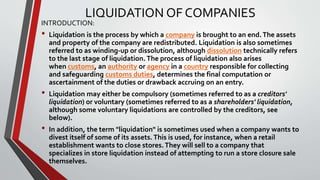Rumored Buzz on Company Liquidation
Rumored Buzz on Company Liquidation
Blog Article
Company Liquidation - The Facts
Table of Contents10 Simple Techniques For Company LiquidationSome Known Details About Company Liquidation The Basic Principles Of Company Liquidation The 9-Minute Rule for Company LiquidationNot known Incorrect Statements About Company Liquidation
A liquidator is especially designated to oversee the ending up of a firm's events in order for it to be shut down generally when the business is declaring bankruptcy. The liquidator is an objective 3rd party that oversees the sale of firm properties in order to pay off any outstanding financial obligations.Their duty includes, but is not limited to: Objective Overseer: A liquidator is entrusted with functioning as an unbiased 3rd party to manage the entire company liquidation procedure. Produce Declaration of Affairs: Liquidators must produce a detailed declaration of events record. This paper is dispersed to financial institutions, outlining the present monetary status of business at the time of its liquidation.
After the liquidation of a firm, its presence is eliminated from Business House and it stops to be a legal entity. If directors browsed the process without problem, there would be no charges or individual responsibility for firm financial obligations anticipated. Now, with a tidy slate, directors can explore new service possibilities, though professional examination is advisable.
4 Simple Techniques For Company Liquidation
For instance, if more than 90% of all firm investors concur, liquidation can happen on short notice within seven days, the minimum statutory notice for creditors. However, normally, the bigger the liquidation and the even more properties and capital the organization has, the longer the process will certainly take. 'Do I need to pay to liquidate my company?', the response will certainly depend on whether or not your service has any kind of properties remaining when liquidating.

We comprehend that no two business are the exact same, which is why we will certainly take the time to be familiar with your organization so we can suggest the very best strategy for you. We just function in your best rate of interests, so you can be entirely positive in the solution we give.
Top Guidelines Of Company Liquidation
In the UK, there is a set process to shutting down or reorganizing a restricted company, whether it is solvent or bankrupt. This procedure is referred to as liquidation and can only be dealt with by a certified insolvency professional (IP) in conformity with learn the facts here now the Insolvency Act 1986. There are four major sorts of business liquidation procedure: Lenders' Voluntary Liquidation (CVL); Obligatory liquidation; Administration; and Members' Volunteer Liquidation (MVL).

In these situations, it is essential that the firm stops trading; if business remains to trade, the supervisors might be held personally responsible and it can cause the insolvency expert reporting wrongful trading, called misfeasance, which might lead to lawful action. The directors select a bankruptcy professional and when this has actually been agreed and validated, there is a conference with the investors.
Certainly, if there are no investors, this action of the process is not needed (Company Liquidation). The IP takes control of the firm and begins the firm liquidation procedure. The supervisors are no longer associated with what happens, including the sale of the firm's assets. Nonetheless, if the directors want any of the assets, they can notify the IP.
Facts About Company Liquidation Uncovered
The major difference is that visit our website the business's lenders related to the court for an ending up order which compels the insolvent business into a liquidation process. Lenders take this action as a last hotel because they have not received payment with various other kinds click for more info of arrangement. The court designates an insolvency practitioner, likewise referred to as a main receiver, to perform the compulsory firm liquidation procedure.
This kind of firm liquidation is not voluntary and directors' conduct is reported to the UK's Secretary of State once the liquidation process has been completed. Consequently, any kind of supervisor that falls short to accept the IP or has actually been associated with supervisor misconduct, or a deceitful act, might result in significant effects (Company Liquidation).
It is used as a way to shield the company from any lawsuit by its creditors. The directors of the business consent to make routine payments to settle their financial obligations over an amount of time. The selected administrator manages the voluntary administration process, and receives the settlements which they after that distribute to creditors according to the concurred amounts.
What Does Company Liquidation Do?
This offers the company with time to establish a plan moving forward to save the firm and avoid liquidation. Nonetheless, at this point, supervisors hand control of the firm over to the selected administrator. If a company is solvent but the directors and investors wish to shut the service, a Participants Volunteer Liquidation is the right alternative.
The company liquidation procedure is handled by a liquidator designated by the supervisors and shareholders of the business and they have to authorize an affirmation that there are no creditors staying. The liquidation procedure for an MVL resembles that of a CVL because possessions are know but the earnings are distributed to the supervisors and the investors of the business after the liquidator's charges have actually been paid.
Report this page